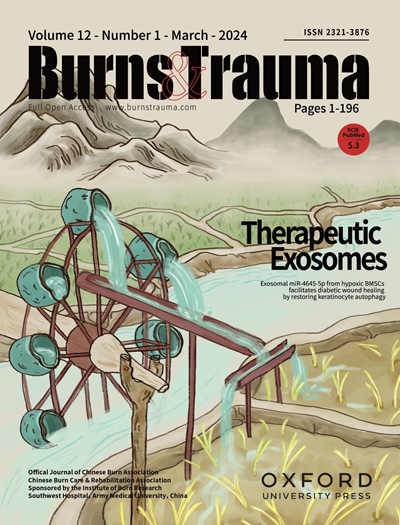机械拉伸增强骨髓间充质干细胞对糖尿病伤口愈合的细胞和旁分泌作用
IF 9.6
1区 医学
Q1 DERMATOLOGY
引用次数: 0
摘要
背景:糖尿病伤口呈现出持续的临床挑战,其特征是细胞外基质(ECM)稳态被破坏,这严重阻碍了组织再生。虽然骨髓间充质干细胞(BMSCs)通过ECM重塑显示出治疗潜力,但传统的移植策略受到细胞保留不佳和短暂治疗效果的限制。方法采用定制的球形细胞拉伸系统对培养于Flexcell板上的骨髓间充质干细胞进行可编程机械拉伸。通过Western blotting和ELISA纵向评估菌株速率和持续时间依赖性对旁分泌信号和ECM分泌的影响。优化后的力学参数(15%变形,1440次循环,5-s顶点停留时间)随后应用于生成BMSC板。在非拉伸组和机械优化组之间进行了生物活性和力学性能的比较分析。在糖尿病大鼠模型中,通过伤口闭合动力学、马松三色染色和新生血管标志物的免疫荧光检测来评估体内治疗效果。通过拉伸激活信号通路的转录组学分析获得了机制见解。结果机械拉伸可显著上调骨髓间充质干细胞中I型胶原、III型胶原、血管内皮生长因子(VEGF)和转化生长因子-β (TGF-β)的分泌。优化的拉伸参数(15%变形,1440次循环,5 s顶点停留时间)促进了BMSC增殖,同时减少了细胞凋亡,而不影响干细胞的干性。机械拉伸促进了层状细胞片的形成,胶原沉积更有组织,机械强度更高,通过增强再上皮化和新生血管加速糖尿病大鼠伤口愈合。RNA测序分析显示,机械拉伸显著上调机械敏感分子、机械刺激信号通路和细胞行为调节通路,特别是与机械刺激反应、整合素结合、ECM分泌和细胞间粘附相关的通路。结论机械拉伸BMSC细胞片可通过增强细胞活性、生长因子旁分泌和ECM成分促进糖尿病创面愈合。本文章由计算机程序翻译,如有差异,请以英文原文为准。
Mechanical stretching enhances the cellular and paracrine effects of bone marrow mesenchymal stem cells on diabetic wound healing
Background Diabetic wounds present persistent clinical challenges characterized by disrupted extracellular matrix (ECM) homeostasis, which critically impedes tissue regeneration. While bone marrow-derived mesenchymal stem cells (BMSCs) exhibit therapeutic potential through ECM remodeling, conventional transplantation strategies are limited by suboptimal cell retention and transient therapeutic effects. Methods BMSCs cultured on Flexcell plates were subjected to programmable mechanical stretching using a custom-built spherical cell-stretching system. Strain rate- and duration-dependent effects on paracrine signaling and ECM secretion were longitudinally assessed through Western blotting and ELISA. The optimized mechanical parameters (15% deformation, 1440 cycles, 5-s vertex residence time) were subsequently applied to generate BMSC sheets. Comparative analyses of biological activity and mechanical properties were performed between non-stretched controls and mechanically optimized groups. In vivo therapeutic efficacy was evaluated in diabetic rat models through wound closure kinetics, Masson’s trichrome staining, and immunofluorescence detection of neovascularization markers. Mechanistic insights were obtained via transcriptomic profiling of stretch-activated signaling pathways. Results Mechanical stretching significantly upregulated type I collagen, type III collagen, vascular endothelial growth factor (VEGF), and transforming growth factor-beta (TGF-β) secretion in BMSCs. The optimized stretching parameters (15% deformation, 1440 cycles, and 5 s vertex residence time) promoted BMSC proliferation while reducing apoptosis without compromising stemness. Mechanical stretching facilitated the formation of layered cell sheets with more organized collagen deposition and higher mechanical strength, expediting wound healing in diabetic rats through enhanced re-epithelialization and neovascularization. RNA sequencing analysis revealed that mechanical stretching significantly upregulated mechanosensitive molecules, mechanical stimulation signaling pathways, and cellular behavior regulatory pathways, particularly those associated with mechanical stimuli response, integrin binding, ECM secretion, and intercellular adhesion. Conclusions Mechanically stretched BMSC cell sheets can promote diabetic wound healing by enhancing cellular activity, paracrine of growth factors, and ECM components.
求助全文
通过发布文献求助,成功后即可免费获取论文全文。
去求助
来源期刊

Burns & Trauma
医学-皮肤病学
CiteScore
8.40
自引率
9.40%
发文量
186
审稿时长
6 weeks
期刊介绍:
The first open access journal in the field of burns and trauma injury in the Asia-Pacific region, Burns & Trauma publishes the latest developments in basic, clinical and translational research in the field. With a special focus on prevention, clinical treatment and basic research, the journal welcomes submissions in various aspects of biomaterials, tissue engineering, stem cells, critical care, immunobiology, skin transplantation, and the prevention and regeneration of burns and trauma injuries. With an expert Editorial Board and a team of dedicated scientific editors, the journal enjoys a large readership and is supported by Southwest Hospital, which covers authors'' article processing charges.
 求助内容:
求助内容: 应助结果提醒方式:
应助结果提醒方式:


